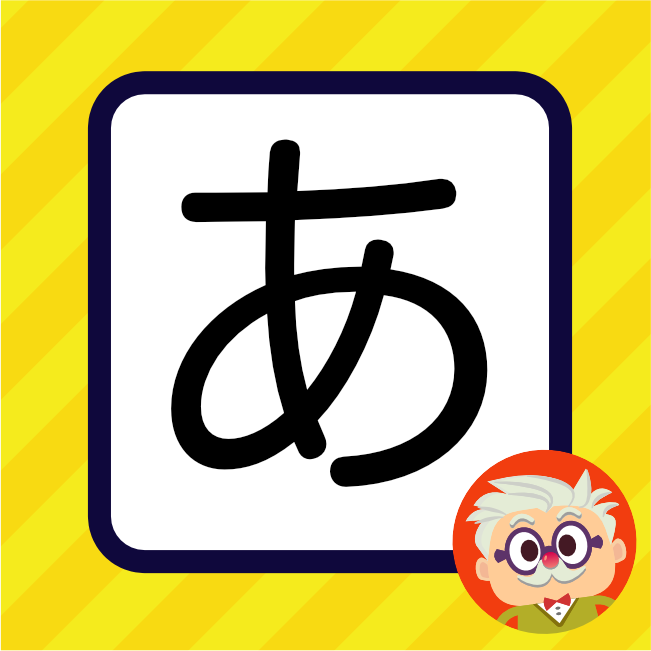
Learn Hiragana: A complete guide Part Two
You can find the first part here which covers all of the basics
Freebie!
Grab our handy pdf worksheet to help practice writing Hiragana
Hiragana ka か
So we’ve covered the vowels, let’s keep going!
か is the question particle used at the end of a phrase.
おなまえはなんですか。
Onamae wa nan desu ka.
What's your name?
The katakana counterpart to か is カ. They look very similar so should be easy to remember. Don’t mix them up with the kanji 力 though.
How to write Hiragana ka か
The Hiragana か is made with 3 strokes. Start from the middle left with a horizontal line that curves down vertically and then hooks inwards at the end.
Follow this up with a vertical line from the top intersecting through the middle of the previous horizontal line and curving left slightly at the bottom. Finish with a small diagonal dash on the upper right of the character.
Word samples using Hiragana ka か
かわ Kawa (River)
かいしゃ Kaisha (Company)
かぞく Kazoku (Family)
かさ Kasa (Umbrella)
Mnemonics to help learn Hiragana ka か
Watch the video below to see one of our mnemonics or try our App to get ALL Hiragana and Katakana mnemonics.
Hiragana ki き
き is pronounced like the word “key”.
The handwritten き looks like a nose and a mouth.
A long きい sound, often written キーッ is an onomatopoeic sound similar to the English 'creak' or 'screech'.
How to write Hiragana ki き
The katakana counterpart to き is キ. Both have two horizontal lines intersecting a vertical line. Remember for き the top horizontal line is longer whereas for キ the bottom generally is. They are the same length in most typed fonts, however.
Word samples using Hiragana ki き
き Ki (Wood)
ひき Hiki (Counter for animals)
きっぷ Kippu (Ticket)
きって Kitte (Postage Stamp)
Mnemonics to help learn Hiragana ki き
Try our App to get ALL Hiragana and Katakana mnemonics.
Hiragana kuく
く is pronounced like the coo in “cool”
A long くう sound, often written クー, is an onomatopoeic sound for sleeping like the English zzzz.
The katakana counterpart to く is ク.
This character has several uses.
How to write Hiragana ku く
The Hiragana く is made with 1 stroke. Start from the top and make the shape in a one-two motion stroke. Think of it like an arrow < or perhaps a nose like き.
Word samples using Hiragana ku く
くち Kuchi (Mouth)
くろ Kuro (Black)
くつした Kutsushita (Socks)
くも Kumo (Cloud )
Mnemonics to help learn Hiragana ku く
“KuKu!” Just like a cuckoo bird!
Watch the video below to see one of our mnemonics or try our App to get ALL Hiragana and Katakana mnemonics.
Hiragana ke け
け is pronounced like the character K or “kay”.
けっ is a derisive short laugh, comparable to the English “Pfft”.
The katakana counterpart to け is ケ. It’s quite similar to ク.
How to write Hiragana ke け
The Hiragana け is made with 3 strokes. Start with the left vertical line, slightly curved from top to bottom. The hook at the end is optional when handwritten. Make the horizontal stroke 1/3rd from the top of the character, then intersect this line with the other vertical stroke and have it curve inwards at the bottom end.
Word samples using Hiragana ke け
けっこん Kekkon (Marriage)
けいさつ Keisatsu (Police)
けんきゅう Kenkyū (Study)
けいざい Keizai (Economy)
Did somebody say Quiz?
In the Dr. Moku app you get lots of different quiz modes, reading practice, and of course; the complete mnemonic system for Hiragana and Katakana.
Hiragana ko こ
こ is pronounced like co in “Coca-Cola”.
In Manga, こっ is onomatopoeia for footstep sounds.
The katakana counterpart to こ is コ.
How to write Hiragana ko こ
Start with the top horizontal line. Its hook end is optional. It can be curved or straight.
Then start the bottom line with a short vertical curve that goes into the horizontal line. Roughly the same length. It’s basically け flipped and sideways, only missing the 2nd stroke.
Word samples using Hiragana ko こ
こ Ko (Child)
こな Kona (Flour)
ことば Kotoba (Word, language)
こうえん Kōen (Park)
こえ Koe (Voice)
Stroke animation and sample Japanese words can be found in the video:
Hiragana sa さ
さ is pronounced like the sa in “satin”
The Hiragana さ is made with 3 strokes. (Note: the handwritten version of this character differs from the print version much like き)
You’ll sometimes hear people say さあ meaning, “who knows” or “I don’t know.”
The katakana counterpart of さ is サ.
How to write Hiragana sa さ
Start with the horizontal line through the middle. It can curve upwards slightly. Now draw the slanting vertical line intersecting this line, and end it with a short left horizontal hook.
Finish with a curved line, like the left side of a smile. at the base of the character.
It’s き, only missing 1 of the horizontal lines.
Word samples using Hiragana sa さ
さ Sa (Difference, variation)
さんぽ Sanpo (Walk, stroll)
さいふ Saifu (Wallet)
さとう Satō (Sugar)
Hiragana shi し
し is pronounced like the word “she”.
Note: there’s no “si” sound in native Japanese, only shi.
し can be added to the end of verb conjunctions to mean also or and. A long しいい is how one says “shhh” or “shush” in Japanese.
The katakana counterpart of し is シ, not to be mixed up with the other katakana ツ.
Is there a Si in hiragana?
No, but this is a reasonable question considering that most of Hiragana and Katakana follow the A, I, U, E, O pattern! Read some conjecture about the subject here.
Does Japanese have a “zi” sound?
Yep. When we add Dakuten (the two little strokes in the top right corner) to し it creates じ zi.
How to write Hiragana shi し
The Hiragana し is made with 1 stroke. Start from the top vertically and curve in horizontally at the base.
Word samples using Hiragana shi し
し Shi (Four)
しごと Shigoto(Work)
しんぶん Shinbun (Newspaper)
しみん Shimin (Citizen)
しじん Shijin (Poet)
Mnemonics to remember Hiragana shi し
She has Shiny Hair! This character looks like the swoop of a girl’s hair.
Hiragana su す
す is pronounced like the name “Sue”.
The Hiragana す is made with 2 strokes.
す is part of the verb to breathe/smoke: “すう”. Kanji: 吸う.
The katakana counterpart of す is ス, not to be mixed up with the other katakana ヌ.
す comes from the cursive form of the kanji 寸. You can find more about the origin of this character here
How to write Hiragana su す
Start with the horizontal line. Then make the vertical line intersect slightly right of the middle with the loop below this and a left curving tail at the base.
Word samples using Hiragana su す
す Su (Nest)
すいどう Suidō (Water supply)
すうがく Sūgaku (Mathematics)
すいえい Suiei (Swimming)
すな Suna (Sand )
Mnemonics to remember Hiragana su す
Super Sumo!
Lets get physical
Get the entire Hiragana and Katakana system in our jam-packed flashcard deck.
Available now on Amazon.com.
Hiragana se せ
せ is pronounced like the word “say”.
The Hiragana せ is made with 3 strokes.
A common adverb using the character is せっせと, meaning diligently.
The katakana counterpart of せ is セ. They look quite similar.
How to write Hiragana se せ
Start with the horizontal line. It can be slightly slanting upwards.
Then make the right vertical line, hooking into the left at its bottom.
Finish with the left side vertical line, curving into the right horizontally past the right vertical line from before.
Word samples using Hiragana se せ
せんせい Sensei (Teacher)
せんたく Sentaku (Washing, laundry)
せびろ Sebiro (Business suit)
せっけん Sekken (Soap)
Mnemonics to remember Hiragana se せ
This looks just like a huge syringe going into an arm. So think “I SEriously hate syringes”. This mnemonic will really stick if you visualize your own arm.
Hiragana so そ
そ is pronounced like “so” in “soda”
そう is a widely used word that can change in meaning drastically based on tone and intonation.
On its own, it means, “I see”. It can be used to express disappointment, surprise, agreement or confirmation, and is often paired with particles like か、ね、よ、だ to add and clarify these meanings.
The katakana counterpart to そ is ソ. It’s like ツ only with one dash or “eye”.
How to write Hiragana so そ
The Hiragana そ is made with 1 stroke. Start small at the top then cut back diagonally down followed by a longer horizontal line in the middle. End with an inward semicircle curve.
Word samples using Hiragana so そ
そうじ Sōji (Cleaning)
そつぎょう Sotsugyō (Graduation)
そと Soto (Outside)
そんざい Sonzai (Existence)
そうおん Sōon (Noise)
Animated stroke order and sample words with pronunciation can be found in this video:
Hiragana ta た
た is pronounced like the “to” in “tomato” so long as the speaker doesn’t over-emphasize the o sound in it. (American English).
The first part of this character looks a bit like a “t”. Then it has a small こ. たたた is often used as an onomatopoeia for running.
It can also be a yell or battle cry. (Eg. Link swinging a sword going ター!) The katakana counterpart to た is タ. Similar to ク.
How to write Hiragana ta た
た is made with 4 strokes. Start with the short horizontal line. Then intersect the line right in the middle with the long slanting vertical line.
Next is the small こ. Start with the top horizontal line. Its hook end is optional. The line can be curved or straight. Then make the bottom line with a short vertical curve that goes into the horizontal line. Roughly the same length.
Word samples using Hiragana ta た
だれ Dare (Who)
たばこ Tabako (Tobacco)
たまご Tamago (Egg)
たいしかん Taishikan (Embassy)
たんじょうび Tanjōbi (Birthday)
Hiragana chi ち
ち is pronounced like the “chee” in “cheese”
Note: the“ti” sound is not native to Japanese, so you’ll only ever encounter it in foreign words in Japanese. If it’s a foreign word, the “ti” sound can be written like so: ティ with a small katakana い modifying the te sound to ti.
ち can be used to represent the sound of a tongue click, which is often used to express disapproval or frustration.
How to write Hiragana chi ち
ち is made with 2 strokes. Start with a short horizontal line. Follow with a left slanting vertical line intersecting the previous line and then cutting right and looping back around to the base on the left of the character.
Word samples using Hiragana chi ち
ち Chi (Blood)
ちかてつ Chikatetsu (Subway)
ちから Chikara (Power, force)
ちちおや Chichioya (Father)
ちきゅう Chikyū (Earth)
Hiragana tsu つ
つ is pronounced like “tsu” in “tsunami”.
Note: Tsu is not a syllable in any English words. The Japanese word Tsunami is often pronounced “sunami” by English speakers, but this is not how a Japanese speaker would say it.
Start with the syllable “to”, then try “sew”. You need to locate the tsu syllable between these two sounds, or by combining these two sounds.
Note: Unlike ti Eg. “ティ”, tsu is almost never written in katakana for foreign words and most native speakers just use the tsu character for it. つう is an onomatopoeia for buzzing like the English bzzz. The katakana counterpart to つ is ツ. Not to be mixed up with シ.
A small つ also indicates a double consonant. Check this link for more information.
How to write Hiragana tsu つ
つ is made with one smooth stroke. Like the bottom of ち, start from the top and loop back around to the base on the left of the character..
Word samples using Hiragana tsu つ
つなみ Tsunami
つり Tsuri (Fishing)
つうがく Tsūgaku (Commuting to school)
つばさ Tsubasa (Wing)
つゆ Tsuyu (Rainy season)
Mnemonics to remember Hiragana tsu つ
It doesn’t get any easier than this one: it looks just like a tsunami wave!
Hiragana te て
て is pronounced like the “tai” in “tailor”.
て is the word for hand. It’s kanji is 手.
The katakana counterpart to て is テ, not to be mixed up with the Japanese postal mark 〒.
You can find more about the many uses of this character here.
How to write Hiragana te て
The Hiragana て is made with 1 stroke. Write in one stroke, starting with the upper horizontal line and then curving vertically inward. The bottom half of そ.
Word samples using Hiragana te て
て Te (Hand)
てがみ Tegami (Letter)
てぶくろ Tebukuro (Gloves)
てんらんかい Tenrankai (Exhibition)
てつどう Tetsudō (Railroad)
Hiragana to と
と is pronounced like the word “toe”.
とis a connecting particle meaning “and”. The particle is also used in marking speech and thought.
Example: わたしはにくとサラダをたべました。
Watashi wa niku to sarada o tabemashita.
I ate meat and salad.
The katakana counterpart to と is ト. They both have 2 strokes.
How to write Hiragana to と
Start with a short vertical line. Follow with a long curving line connecting at the base of the previous line..
Word samples using Hiragana to と
とし Toshi (Year)
とけい Tokei (Clock)
としょかん Toshokan (Library)
とくべつ Tokubetsu (Special)
とき Toki (Time)
Mnemonics to remember Hiragana to と
A thorn in my toe!
Hiragana na な
な is pronounced like the final “na” in “banana”.
な is an end-of-phrase particle used to show your confirmation/agreement.
にほんへいきたいな。
Nihon e ikitai na.
I want to go to Japan, don't I?
The katakana counterpart to な is ナ. The left part of な looks similar to ナ.
How to write Hiragana na な
The Hiragana な is made with 4 strokes. Start with the left horizontal one. Intersect it with the left slanting vertical line. Make a small dash to the right starting at the same height as the horizontal line.
Finally, start a vertical line that does a full loop to the left at its bottom and completes by moving in a horizontal curve to the right base of the character.
Word samples using Hiragana na な
なまえ Namae (Name)
なつ Natsu (Summer)
なる Naru (To become)
なみだ Namida (Tear)
なみ Nami (Wave)
Hiragana ni に
に is pronounced like the word “knee”
に is the number 2. (The kanji for the number 2 is 二)
に is also a directional and location particle. It has many uses you will learn with time.
ねこはテーブルにいます。
Neko wa tēburu ni imasu.
The cat is on the table.
How to write Hiragana ni に
Start with the left horizontal one. Intersect it with the left slanting vertical line. Make a small dash to the right starting at the same height as the horizontal line.
Finally, start a vertical line that does a full loop to the left at its bottom and completes by moving in a horizontal curve to the right base of the character.
Word samples using Hiragana ni に
に Ni (Two)
にし Nishi (West)
にんぎょう Ningyō (Doll)
にっき Nikki (Diary)
にんげん Ningen (Human)
Hiragana nu ぬ
ぬ is pronounced like the word “new”
Not to be confused with the Hiragana め which is “me”.
Its use with a questioning intonation “ぬ?” is similar to the English “Hm?” in both sound and meaning.
The katakana counterpart to ぬ is ヌ.
How to write Hiragana nu ぬ
Start with the small rightward curved vertical line. Follow with a mirrored leftward curved line that loops around, intersecting with itself once and the first stroke twice.
This stroke ends with a small full loop at the bottom right of the character.
Word samples using Hiragana nu ぬ
ぬすむ Nusumu (To steal)
ぬま Numa (Swamp)
ぬる Nuru (To paint)
ぬれる Nureru (To get wet)
Hiragana ne ね
ね is pronounced like the word “Nay”.
ね is an after phrase particle used for emphasis/to ask for confirmation. It’s similar to the English “right”?
ちょっとたかいですね。
Chotto takai desu ne
It’s a little bit expensive, isn’t it?
The katakana counterpart to ね is ネ.
How to write Hiragana ne ね
Start with the straight vertical line. Intersect the side of this line with the start of the 2nd stroke a little above its middle.
Then cut back diagonally left and down. From there, retrace the stroke slightly prior to curving out wide to the right. End with a small full loop at the base.
Word samples using Hiragana ne ね
ねこ Neko (Cat)
ねったい Nettai (Tropics)
ねずみ Nezumi (Rat)
ねる Neru (To sleep)
ねだん Nedan (Price)
Hiragana no の
の is pronounced like the word “no”
の is the possessive particle. Think of it like the possessive “ ‘s ” of English or the word “of”.
わたしのえんぴつです。
Watashi no enpitsu desu.
It's my pencil.
The katakana counterpart to の is ノ. It’s like ナ with one less line.
How to write Hiragana no の
Start with the straight vertical line. Intersect the side of this line with the start of the 2nd stroke a little above its middle.
Then cut back diagonally left and down. From there, retrace the stroke slightly prior to curving out wide to the right. End with a small full loop at the base.
Word samples using Hiragana no の
ぬすむ Nusumu (To steal)
のりもの Norimono (Vehicle)
のうか Nouka (Farmer)
のうぎょう Nōgyō (Agriculture)
Hiragana Mnemonic Time!
No Smoking! の clearly resembles a no smoking sign, play the video below for the animated mnemonic device.

Part Three is right here
What next? Try the Dr. Moku app for the complete Mnemonic system, Hiragana Quiz Modes, Reading Practice and More. You can also learn Katakana and Kanji using the same mnemonic memory tricks.



